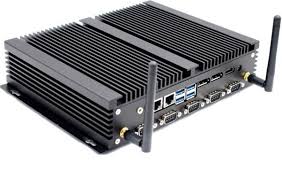In fanless computing, efficiency, reliability, and sustainability are their priorities! Fanless computers are rewriting the script for modern work and life. Join us on this thrilling journey as we delve into how these devices address diverse needs, from saving energy to reducing noise and thriving in tough environments. Get ready for an exhilarating exploration of the world of fanless computing!
How Fanless Technology Works
Fanless technology boldly discards the need for noisy fans traditionally used to dissipate heat from electronic components. Instead, it embraces innovative thermal management techniques, featuring key components like heat sinks or heat pipes. These components deftly absorb and transfer heat away from important elements, spreading it across a larger surface area for gradual dissipation into the surrounding environment.
Another method employed is conduction cooling, utilizing specialized materials with exceptional thermal conductivity to transfer heat away from hotspots within the device. Placed strategically in direct contact with important components, these materials act as conduits, efficiently transferring excess heat away from sensitive areas. Many fanless devices also incorporate vented casings made of high-quality materials, facilitating passive cooling with vents and fins that promote efficient dissipation.
By embracing these intelligent design strategies, fanless technology ensures reliable operation without compromising performance or longevity. The absence of moving parts like fans significantly reduces maintenance requirements while enhancing overall system reliability, making fanless technology a compelling choice for various industries, from industrial automation to home entertainment systems.
Benefits of Using Fanless Computers
Energy Efficiency and Cost Savings
Fanless computing technology actively demonstrates remarkable energy efficiency, delivering substantial cost savings for businesses and individuals alike. By removing cooling fans, these computers actively consume less power than their traditional counterparts, resulting in reduced electricity bills and overall energy consumption. Equipped with efficient thermal management systems that employ passive cooling methods like heat sinks or heat pipes, fanless computers actively dissipate heat without requiring noisy fans.
Moreover, beyond energy savings, this silent operation actively fosters a more comfortable working environment. The absence of moving parts, such as fans, actively contributes to longevity, thereby reducing maintenance costs and downtime. Additionally, the reduced heat emission from fanless computers indirectly alleviates the strain on air conditioning systems in areas housing multiple computers, providing further cost savings.
In essence, fanless computing technology stands out as a proactive solution, offering not only energy efficiency but also enhanced comfort and long-term cost-effectiveness.
Noise Reduction and Improved Air Quality
Compared to traditional computer systems with cooling fans, fanless computing technology actively reduces noise levels. Without involving any moving parts in the cooling process, fanless computers operate silently, promoting concentration and ensuring a more pleasant experience, particularly in quiet environments.
Additionally, fanless computers actively contribute to better air quality. Unlike traditional systems that pull in external air, potentially introducing dust and contaminants, fanless computers utilize passive cooling methods, thereby preserving cleaner air for both users and internal hardware. Fanless computing technology provides a quieter and healthier computing environment by eliminating noise pollution and enhancing air quality.
Durability and Reliability in Harsh Environments
Fanless computing technology excels in durability and reliability, especially in challenging environments. Traditional systems with fans are vulnerable to elements like dust, moisture, and temperature extremes. Fanless computers, designed to withstand such conditions, have a key advantage with the absence of moving parts.
The elimination of fans reduces the risk of clogging or failure due to dust accumulation, making fanless computers ideal for dusty industrial or outdoor settings. Constructed with robust materials tested against vibration, shock, and temperature fluctuations, these computers ensure exceptional durability. In addition to durability, fanless computers offer outstanding reliability.
The absence of fans reduces the likelihood of mechanical failures, prolonging the device’s lifespan. In harsh conditions such as high temperatures in factories or vibrations near heavy machinery, fanless computing technology ensures uninterrupted operations. From offshore oil rigs to manufacturing plants, fanless computing solutions thrive in challenging environments, providing enhanced durability and reliability where other systems may falter.
Applications of Fanless Computing Technology
Fanless computing technology actively serves diverse applications across various industries and settings, leveraging its unique advantages. Here are some key applications:
- Healthcare Facilities:
In healthcare environments, fanless computers serve as silent heroes due to their noiseless operation and minimal heat generation. They play essential roles in patient monitoring, electronic health record management, and medical imaging systems.
- Industrial Environments:
In industrial environments like manufacturing plants and mining operations, fanless computers excel, enduring extreme temperatures, dust, vibration, and shock. They are essential for process control, data logging, and monitoring important operations.
- Entertainment Venues:
In entertainment settings such as airports, shopping malls, and theaters, fanless computing technology actively takes the spotlight, powering digital signage displays and multimedia kiosks. Their silent operation and reliability actively enhance the overall customer experience without adding background noise.
- Automotive Applications:
Fanless computers actively hit the road in automotive applications, finding places in infotainment systems, navigation systems, and vehicle diagnostics. Their reliability, compact size, and silent operation actively contribute to a comfortable and distraction-free driving experience.
- Home and Office Environments:
In the comfort of home theaters, fanless computers actively transform into media centers (HTPCs), delivering seamless playback of multimedia content without the noise of cooling fans. In office settings, they actively become the backbone for general-purpose computing tasks, conference room displays, and digital signage.
- Outdoor and Harsh Environments:
Fanless computing technology actively steps into the spotlight for outdoor applications, from digital signage in parks to transportation hubs and outdoor events. They actively withstand exposure to weather elements and temperature variations without compromising performance.
Fanless computing technology actively offers reliable and efficient solutions for a wide range of applications across industries, providing silent operation, robust performance, and durability in various environments.
Advancements in Fanless Technology
Recent years have witnessed remarkable advancements in fanless computing technology, reshaping the computing solutions landscape.
- Passive Cooling Techniques:
- Adoption of heat sinks and heat pipes for efficient heat dissipation without noisy fans.
- Enhances system reliability, reduces power consumption, and promotes sustainability.
- Low-Power Processors:
- Integration of low-power processors for impressive performance with minimal heat generation.
- Ideal for applications with space or noise constraints, such as digital signage and industrial automation.
- Enhanced Thermal Management:
- Advancements in thermal management technologies for better temperature regulation.
- Intelligent sensors monitor internal temperatures, adjusting performance dynamically for optimal operation.
- Improved Durability:
- Enhanced durability and ruggedness are achieved through advancements in enclosure materials.
- Withstands extreme temperatures, shock, vibration, dust, and humidity without compromising functionality.
- IoT-driven Innovation:
- Rise of Internet of Things (IoT) devices driving innovation in fanless technology.
- Development of energy-efficient solutions with smaller form factors for increased versatility and connectivity.
Ongoing research and development efforts are pushing the boundaries of fanless technology, promising more exciting developments in the years to come. These innovations continue to revolutionize how we interact with technology across various domains.
Conclusion
Fanless computing has transformed our interaction with computers gaining popularity across industries. By bidding farewell to cooling fans these computers emerge as energy-efficient, cost-effective champions that promote a quieter work environment. The applications of fanless computing are diverse, spanning from industrial automation to medical devices.
In comparison to fan-based systems, fanless technology takes the lead in reducing energy consumption and workplace noise disruptions. As ongoing advancements in fanless technology enhance performance, efficiency, and reliability, embracing fanless computing brings notable benefits, including energy efficiency, noise reduction, and durability. The journey of fanless computing continues, promising exciting developments in this ever-evolving technological landscape. Buckle up for what lies ahead!











